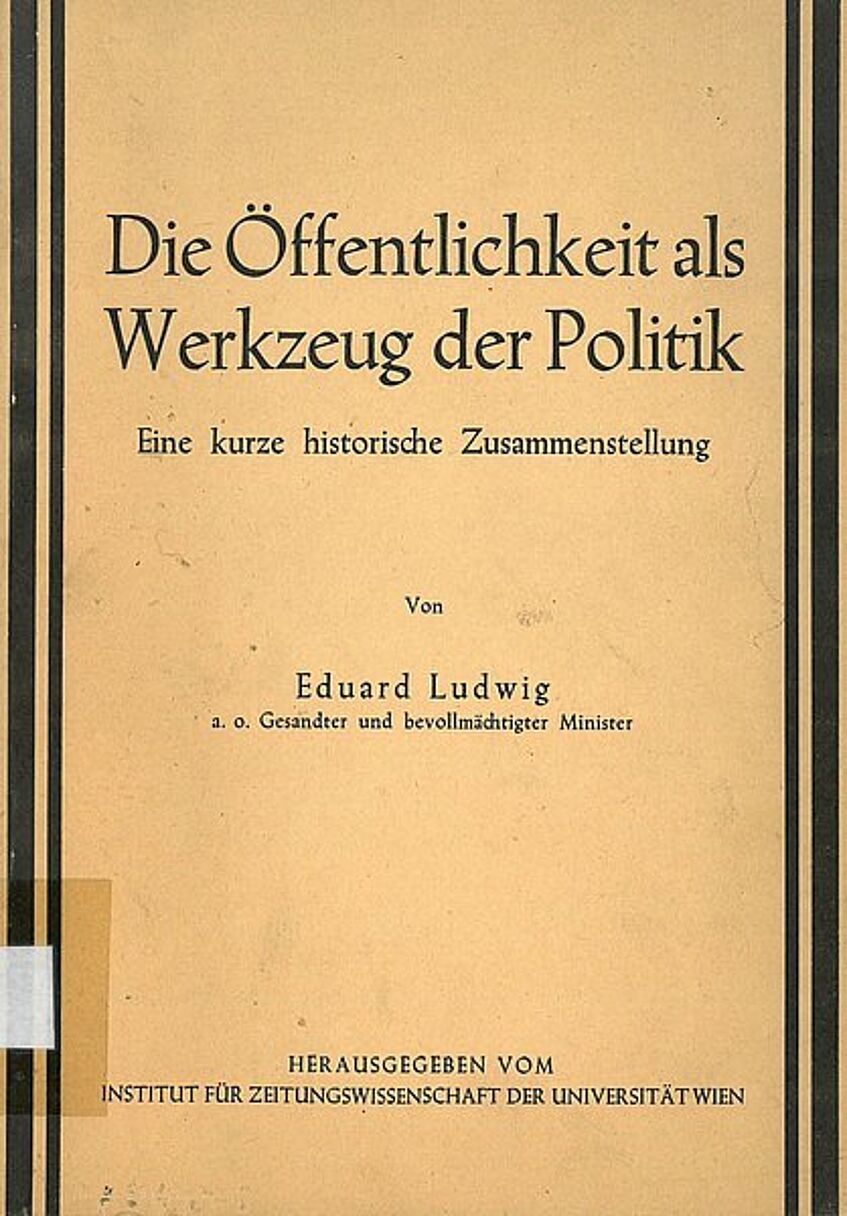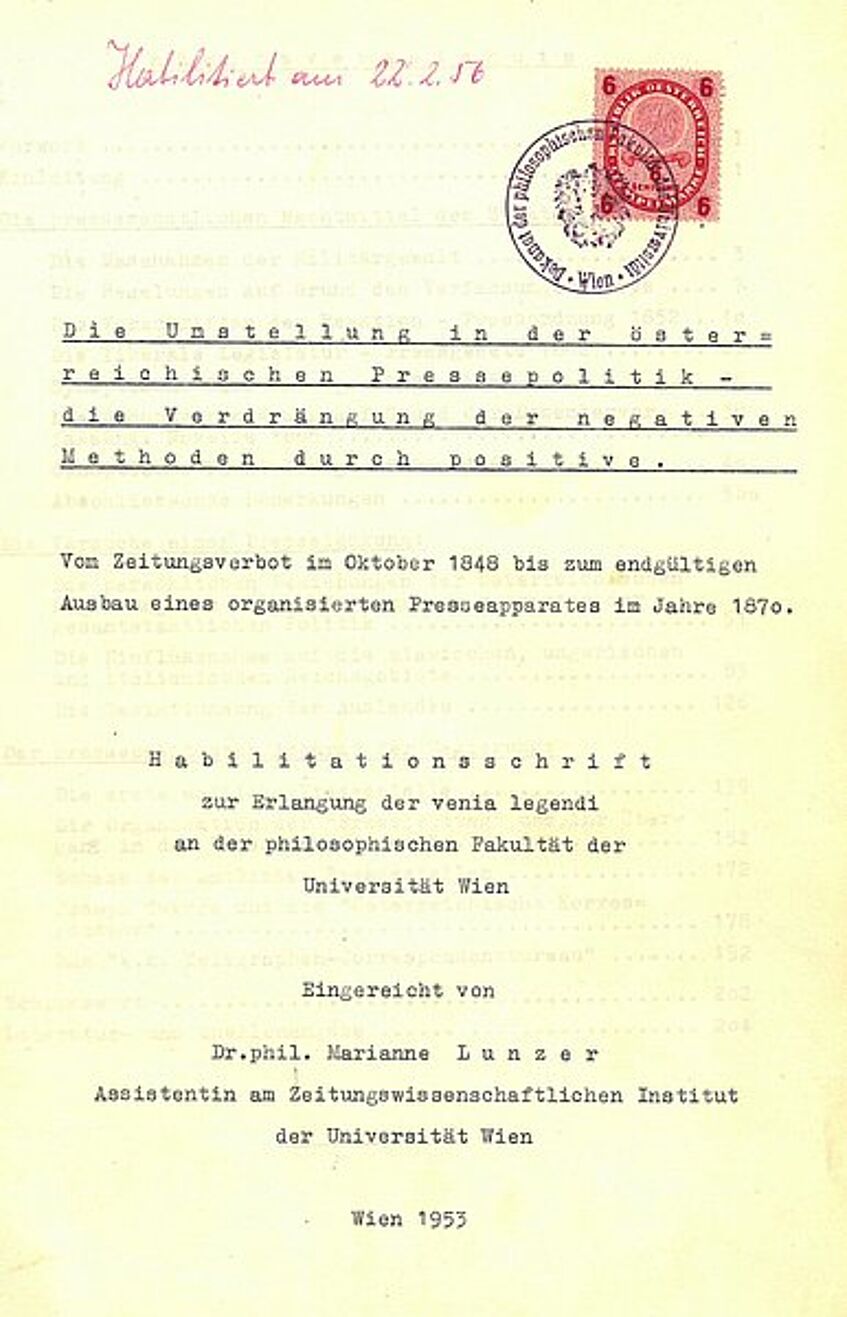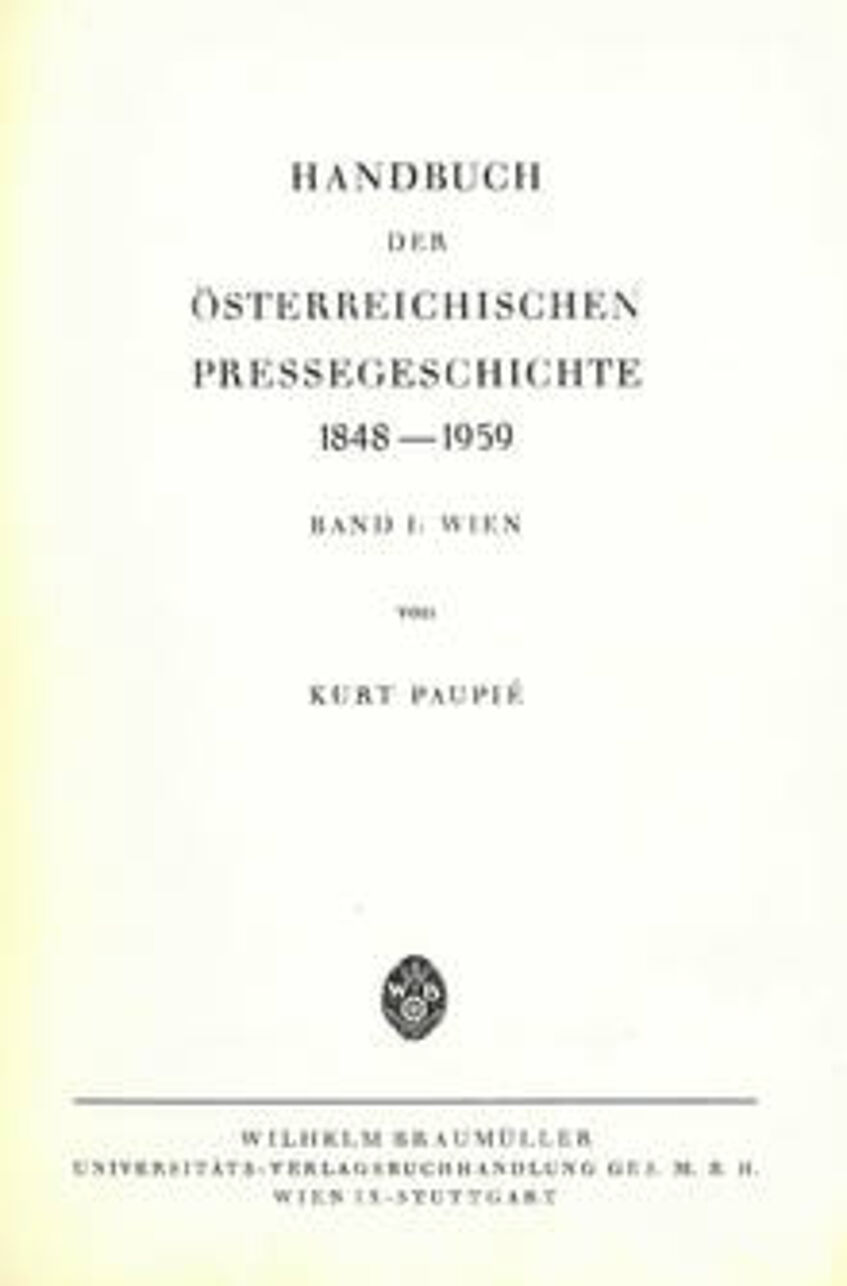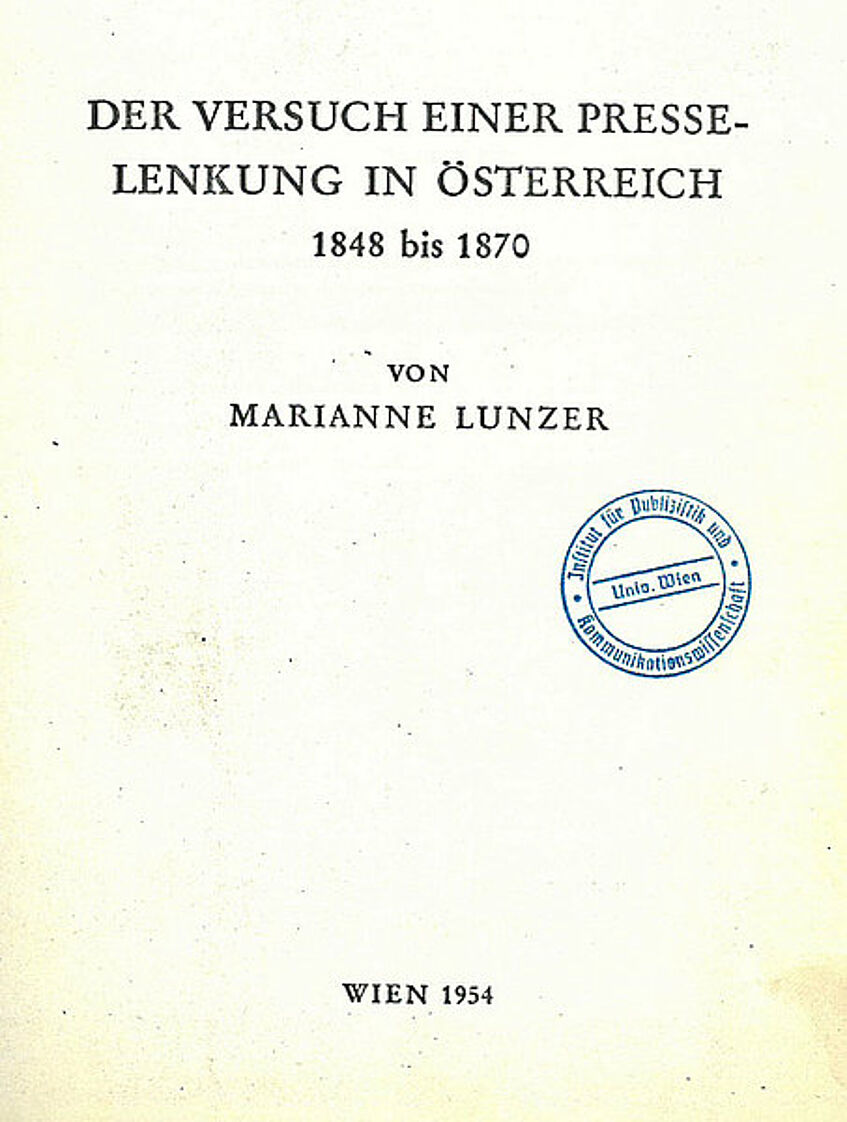The following account focuses on significant periods and key events in the history of the Department, from its official creation in May 1942 to the transformation of newspaper studies into communication science in the early 1970s, with an additional description of some of the factors influencing this academic field, which was subsequently to flourish. Overall, this retrospective look at our Department attempts to link our personal and our structural history. The role and function of the Department during the Third Reich are therefore considered more intensively compared with incidents affecting later generations, so as to avoid simply sweeping this chapter of ideological influence under the carpet and dismissing it as a "dark period" in our history. Then, we deal with the reasons for the Department’s new beginning in the 1946 summer semester, the courses on offer during the post-war period and in the early days of the "economic miracle", and the problems that afflicted the leadership of the Department over a 20-year period. Our historical review of our Department’s eventful journey ends with a look at the new intellectual positioning, a process that was needed after the leadership was consolidated, and an outline of the spherical conditions and major challenges facing both academic and non-academic staff from the middle of the 1980s onwards.
An article on the Department's history entitled "Die Überwindung vieler schwerer Bürden in langer Zeit – Kennzeichen des Instituts für Publizistik- und Kommunikationswissenschaft" by Wolfgang Duchkowitsch and Hannes Haas was recently published in the book Reflexive Innensichten aus der Universität (edited by Karl Anton Fröschl et al., in German)
- Part I
Before the Anschluss in 1938, newspaper studies enjoyed only ephemeral significance at the University of Vienna. Whilst institutes for newspaper studies were gradually being set up at several universities in Germany in the 1920s and 1930s, starting with the establishment of the Institute for Newspaper Studies in Leipzig (1916), the University of Vienna did not engage at institutional level in any academic treatment of "the press". The range of courses on offer in Vienna merely included sporadic lectures on newspapers, given by Wilhelm Bauer, a German national historian specialising in modern history.
- Part II
The key impetus for the establishment of a newspaper studies institute at the University of Vienna was provided by the Chairman of the Deutscher zeitungswissenschaftlicher Verband (German association of newspaper studies, DZV), Walther Heide, just a few weeks after the Anschluss. His plan proved very popular with both Goebbels and the Reich’s chief press officer, Otto Dietrich. Heide then, acting on behalf of Goebbels, arranged for this Institute to move into the seized premises of the Verlag C. Barth publishing house located at Hessgasse 7 just a stone’s throw from the university building in June 1938, after the publishers were closed down on the grounds of their race. As further preparations were made, Goebbels gave the green light to the Institute’s own budget, which was to be managed by the DZV on a trust basis. The University's professors were less than enthusiastic about the planned Institute, for two reasons: The Institute should not, they felt, be allowed to have any kind of special status either through one-sided material benefits or through the"“cheapening of the doctorate".
The issue of premises for the Institute was quickly resolved, but there was less clarity surrounding personnel. In late 1939 the Institute had an assistant in the person of Wilmont Haacke, but the director's post remained vacant, despite no shortage of applicants for the position. The search for a suitable head took until the end of 1941, when Karl O. Kurth was appointed. Born in 1910 in a small town in Saxony, Kurth joined the SA and NSDAP at the age of 19, was a confidant of Heide, managing director of the DZV, and, for a brief period, headed the Institut für Zeitungswissenschaft (newspaper studies institute) at the University of Königsberg. The Institute was opened to great acclaim on 7 May 1942, viewed as the further conquest of a German university. Vienna, it was felt, had joined the ranks of Berlin, Hamburg, Munich, Münster, Heidelberg, Freiburg, Cologne, Königsberg, Nuremberg and Prague, most of which had set up newspaper institutes or departments before the outbreak of the Second World War.
Heide believed that the Institute's particular task was to be a hub for newspaper studies for South-East Europe. This belief was seconded by the newly installed South-East department of the National Library and by the Union Nationaler Journalistenverbände (union of national journalists’ associations) based in Vienna, which was assigned the role of researching the South-East press.
Thus there were three guarantors of the aim of embracing Austria's historic role in South-East Europe, of using the knowledge acquired about this region, and of elevating Vienna to the position of intellectual gateway to the South-East. Kurth, who narrowed the concept of newspaper studies to news studies, a subject that he co-created, placed the Institute, with its publications, at the service of total war. Equally, the student youth movement was being nurtured and introduced to the "leading" and "crusading" performance of the press unit in Vienna. Contributions to Vienna's daily press from students of the day document just how successful this indoctrination was. In October 1943 Kurth swapped his lectern for a uniform, voluntarily joining up with the Wehrmacht. From then on, the Institute really only operated on a makeshift basis, with the students assuming the ideological function of the Institute through their associations up until the War ended. Their numbers plummeted, however, as a result of the war effort, falling from a high of 162 to just over 100 in the 1944/45 winter semester. By the 1945 summer semester, student numbers had fallen to a mere 52, most of them men.
- Part III
After the War, Kurth was removed from his position at the University. Marianne Lunzer-Lindhausen, née Pig, an assistant at the Institute since 1943, was the only member who had not been involved with the National Socialists and was therefore allowed to remain. Amidst the rubble and devastation, she devoted herself to ensuring the Institute, whose very existence was under threat, was able to survive. The Faculty then ensured that the Institute was given a new intellectual direction in December 1945, arguing that it must be allowed to continue its work, both from the perspective of academic research and in the interests of the state. The argument was made that only a newspaper industry with a "solid foundation" would be able to convey the "state policies to the public at large". In contrast to the working method adopted by the previous Director, teaching was not, however, to take current affairs as its starting point. Rather, the academic presentation of the press was to be the "noblest" foundation on which the education was based. In March 1946, Eduard Ludwig was appointed as the Institute’s Director and was also made an honorary professor. Before the Anschluss he had been chairman of the Österreichische Gesellschaft für Zeitungskunde (Austrian society for newspaper studies). This decision meant that, in terms of personnel, a link had been created to the Akademie der Presse (academy of the press) established within this Society, as if the National Socialist penetration of newspaper studies at the Vienna Institute had been nothing more than an unpleasant and incidental interlude.
Ludwig, who was a member of Parliament for the Austrian People's Party in the National Council until 1949, led the Institute until 1958. During this era of the second generation, the Institute failed to make a name for itself academically. Its work, whilst highlighting the history of the press and the history of public opinion in the tradition of Bauer, and taking account of national and international press developments, was primarily concerned with providing journalism education. In order to optimise the teaching objectives from a current and also a democratic perspective, English and French became compulsory subjects. They were only removed from the syllabus during the year before the Austrian State Treaty was signed in 1955. During the late 1950s the Department reacted to the economic upturn by adding market and opinion research as well as advertising to the curriculum. These areas were taught by external teaching staff as had previously been the case and continued to apply in the practical field of journalism. Internal teaching, provided by Lunzer and Kurt Paupié, who had undertaken newspaper studies during the post-war period whilst working as a journalist and initially held a position as a teaching assistant, generally continued to adhere to the traditional duties of newspaper studies.


- Part IV
After Ludwig's departure, neither Lunzer nor Paupié were feasible candidates to take over. Certainly, Lunzer had been qualified as a university lecturer since 1956 but was unable to assert herself in the "man’s world" that the University was at that time. Paupié could not be considered as the process for his postdoctoral lecturing qualification was still pending. His habilitation thesis had been submitted in 1956, but had been rejected on the grounds that it would only be possible for his application to be considered again after further published works had been submitted. He achieved this in 1960 with the publication of the first volume of his Handbuch der österreichischen Pressegeschichte 1848-1959 (handbook of Austrian press history 1848 to 1959). His reward, then, was a permanent position, as the University had already taken the decision in 1958 to place the Institute under extraordinary administration. The position of administrator was filled initially by the historian Heinrich Benedikt and subsequently by the oriental studies specialist Herbert Duda. This state of affairs was maintained for ten years, with Duda’s opinion that newspaper studies constituted nothing more than a historical auxiliary science helping to perpetuate the situation.
- Part V
In 1968 Paupié and Kurth crossed paths again. The latter, after several years working with displaced people, had risen to the position of assistant editor for the "Foreign press" at the Press and Information Centre of the Federal Defence Ministry in the Federal Republic of Germany. Both applied for the newly created chair in newspaper studies. The appointment committee considered their applications "primo et aequo loco", without giving any consideration to the activities of Kurth at the Institute during the days of the Third Reich.
It was judged that Lunzer, who had also applied for the post, was an "excellent teacher" but that, since submitting her habilitation thesis in 1954, had failed to produce any notable publications as a result of "unfortunate family circumstances". Kurth did not succeed in making a return to his former place of work, as the committee, during the second stage of the process, expressed its preference for Paupié on the following grounds: In his favour was the publication in 1996 of the second volume of his Handbuch der österreichischen Pressegeschichte 1848-1959 (handbook of Austrian press history 1848 to 1959), which had been highly rated in a review by Haacke in particular. From the very person then, who in 1942 in the capacity of assistant, wrote a damning report on the Jewish media in Vienna for the Handbuch der Zeitungswissenschaft (newspaper studies handbook) edited by Heide, from which he never distanced himself. What perhaps happened was that events came full circle, since Paupié, when applying for an assistant’s post in 1950 denied under oath having been an illegal member of the Hitler Young from the mid-1930s, a member of the SA from 1 January 1938 and an NSDAP member afterwards, despite the fact those closest to him were well aware of his past.
In 1969 Paupié was appointed as a full professor and as Director of the Institute. Four years later, Lunzer was made an associate professor under the new category. With Paupié at the helm and Lunzer as Deputy Director, lecturing in descriptive press history, the Institute gradually moved away from the modestly contoured newspaper studies of the past. Influenced by innovations in the discipline in West Germany, it began to move towards a discipline with its roots in the social sciences. This process involved reflecting on communication science approaches and models, whilst also looking at principles of "critical rationalism" and "critical theory" and reflecting on and applying social science methods, particularly quantitative content analysis but also qualitative processes as part of reception analysis. This transformation is visible in research projects and publications produced by members of this up-and-coming, ambitious third generation at the Institute, all of whom, as assistants, answered to Paupié. The division of the Institute into a theoretical, applied and historical department reflects the consistency of this development. Questions about how our discipline views itself and about the responsibility of our discipline to society grew increasingly important. Cooperation projects with the young sister institution in Salzburg and with neighbouring disciplines, as well as with communication practice, were supported by the Media and Communication Research project team at the Federal Ministry of Science and Research. Paupié played a part in all of this. Nevertheless, speaking after his death in December 1981, Maximilian Gottschlich, a former assistant to Paupié, rightly stated: "With his passing our discipline has lost neither an illuminating nor an illuminated teacher."



- Part VI
After Paupié's death, Lunzer took over. As Department Chair, she carefully strove to deepen teaching and learning at the Department, while being forced to neglect her own research somewhat for the time being as a chair.
However, her specialisms continued to be women’s journals in Vienna and women as readers in the 18th century, as well as media policy in the First Republic. Lunzer, having experienced the development of the subject as it branched out into the wider field of social sciences, opened up many opportunities to shape research work as it expanded from history of the press to history of communication. Her achievements were exceptional in that she took the opportunity to improve the Department’s image for the long term, an image that for various reasons had suffered greatly within the Faculty.
When Lunzer became an emeritus professor, Wolfgang R. Langenbucher took over the chair in April 1984. In turn, he led the Department until becoming an emeritus professor at the end of September 2006. During his era, when the Department moved into its own premises in Schopenhauerstrasse having long outgrown its old home in the Neues Institutsgebäude (New Institute Building, NIG) (Universitätstraße 7), with the addition of its own departmental library, the number of students grew rapidly. Well in excess of 1,200 school-leavers took up studies in communication science as their main or secondary subject every year, a subject classed as a "trendy subject" in the world of politics and also by the University. This opinion is crass and misplaced given the ongoing interest from students in utilising the courses available, which have been gradually expanded from both a theoretical and practical perspective, as academic preparation for a career in a segment of the communication professions, which are growing ever more sophisticated and specialised. Despite the rush of students, any improvement in the Department’s staffing has only been made at a very modest pace. In fact, it has only been possible for hundreds of student dissertations and academic papers to be handled every year because so many Department employees, professors, lecturers and assistants have blurred the distinction between their working hours and their free time. Some of these teaching staff had 30 and some even as many as 50 dissertations to review per academic year. Such achievements, just like the achievement of coping with the administrative workload of having thousands of students (the highest number recorded was around the 7,000 mark), have been possible for two reasons: Firstly, because all of the staff, both academic and non-academic, have identified with the social aims of the Department and, secondly, because studying communication, at least in the minds of those about to graduate from the Department, is not about choosing a trendy degree program.
Hannes Haas took over as Chair of the Department in 2006. Having already assumed the function of deputy chair for a period of six years, Haas was able to use his time in office to map out a future that would ensure that the Department was consistently driven forward (first endowed professorship for PR research, new professorships, new premises). Since 2010, Klaus Schönbach, previously based at the University of Amsterdam, chaired the Department, which moved into its new premises in Währinger Straße 29 in September 2012.
During the time since his appointment he has developed numerous activities to strengthen the Department’s research focus, to reinforce links with international developments in communication science teaching and research, and to lend what is one of the world’s largest institutes devoted to communication an increasingly professional edge. Starting from March 2014, Klaus Schönbach takes over as Vice-Dean for Resarch at the Northwestern University, Quatar. Jörg Matthes, who joined the department in 2011 from Zurich, has succeeded him as new head of department on February 1, 2014. Since October 1, 2022, Sabine Einwiller is leading the Department as Chair after Jörg Matthes stepped down after 8,5 years.
